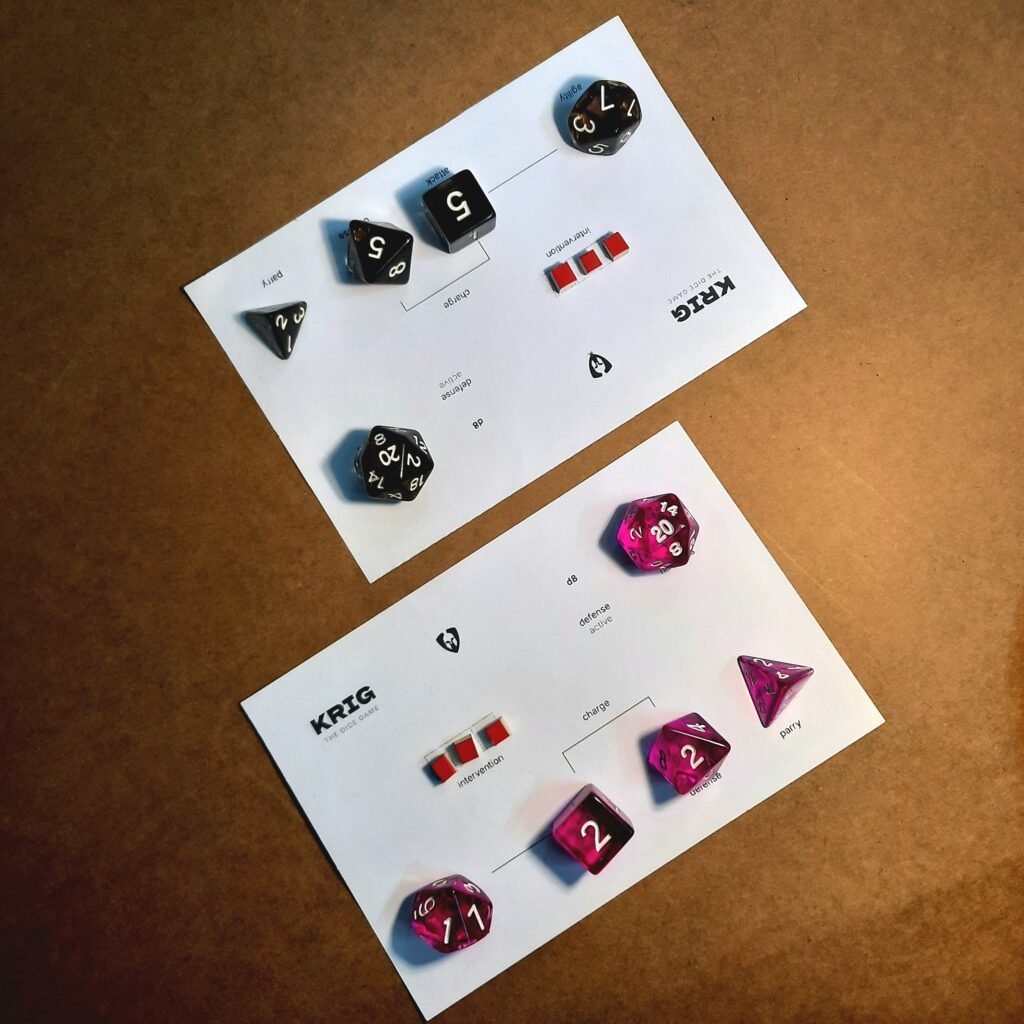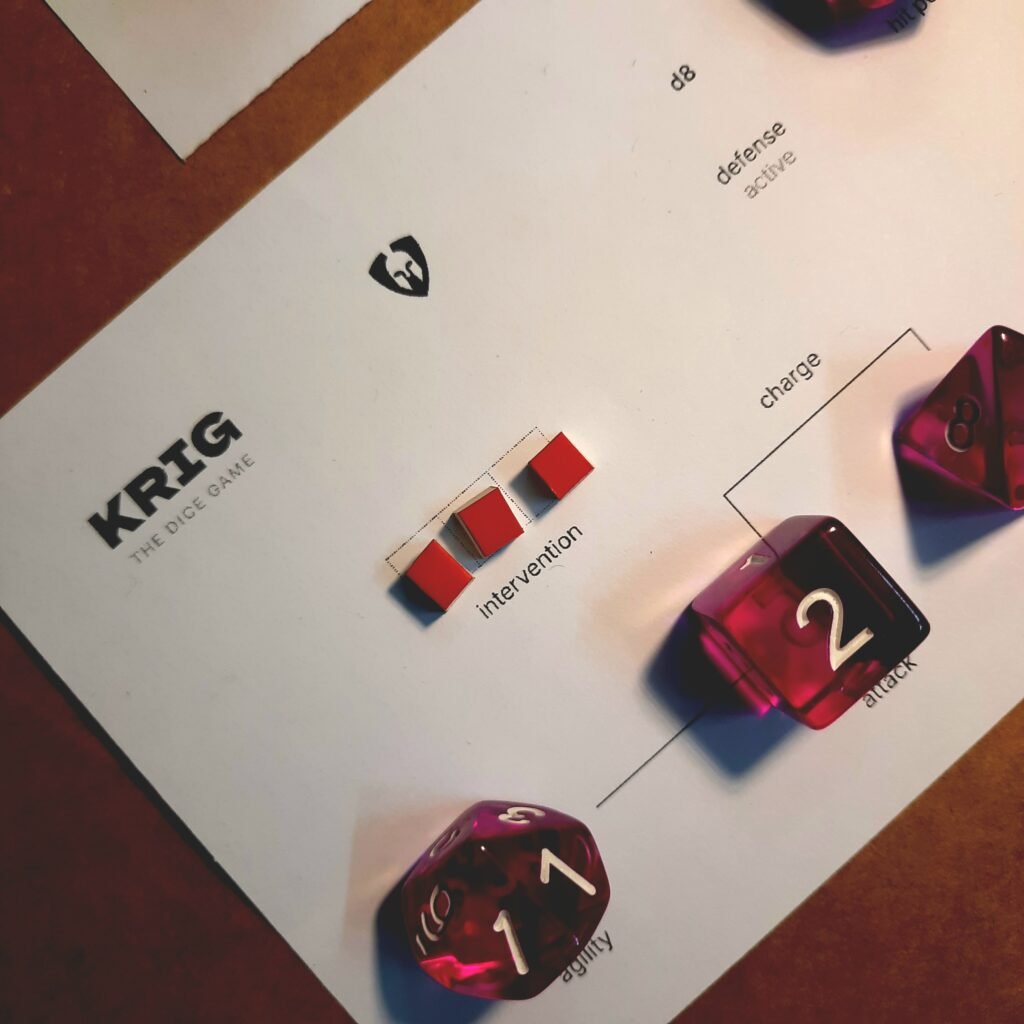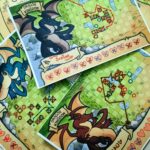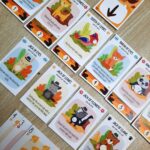Krig Game Review

“Tasliman, you should totally add more games to our game night.”
And so I did!
After playing a handful of print-and-play games, especially over the past 12 months, I recently developed an appetite for fast-paced, competitive games that demand quick decision-making and fit perfectly into any 5-10 minutes of free time I have during the day.
5-10 mins of free time in a day?! Tragically, that’s happening to me a lot lately. Many of you can relate.
Games with such short durations tend to lean more on luck than strategy, but I prefer having at least some level of control over it.
Alongside my newly-found appetite, I’ve also been advised (pressured) by my newly enlisted game night buddies to explore more games for our monthly meetup. They are too lazy to scout, or far too reliant on me for that!
It came to me as a blessing when Alejandro Díaz reached out to me to try a game he originally released in 2019, as he planned to launch an updated version with new mechanics. The game is Krig, a two-player game which uses polyhedral dice to attack, defend, charge and parry in combat.
Stepping out of my conventional solo-player gear, I glanced at the game files, ready to playtest it with my game night pals.
- Is it the fast-paced, competitive game that I was looking for?
- Is it hinged towards luck, or shall I be bestowed with some scopes for strategy?
- Can it be included in our game nights?!
Time to find out.
All you need to play Krig

Krig doesn’t involve a lot of components, and uses items that you may already have if you are a game enthusiast:
– A sheet of paper to print. I playtested the game using the black and white printable boards, though Alejandro mentioned that a full color version will be launching soon.
– 2 sets of polyhedral dice. Meaning, 2 sets of D4, D6, D8, D10, and D20 dice. If you don’t have them, make sure to visit the link I provided for polyhedral dice (at a very reasonable price) at the end of the article.
– 6 small cubes. I made them by cutting 5mm processed wood that I had available from a game project. The printable board is designed to accommodate 8mm wooden or acrylic cubes.
As for learning the game, I saw the game tutorial + playthrough video of Riffle Shuffle & Roll! Find the video at the end of the article.
That’s it. And now, onto answering the three questions that I had in mind, after playing the game multiple times in the space of a week!
Fast-paced and competitive?
My friends and I played multiple rounds of Krig in the space of an hour; the game really picked up pace as we played and watched others dive in as well. The average game time lasted 10 minutes at max, with almost all of them having a climactic ending.
It’s a 1v1 game, so competitiveness comes to it by default. However, what made the game interesting was the multiple ways we could combat our opponents. We tried the defensive approach, a full-on offensive strategy, and the mixture of both. We figured you have to be mindful of every step you take since opportunity cost factors in throughout the game, something I really loved.
This also keeps the game quite fresh, hence replayable. Another big green flag!
Too heavy on luck?
I had the opportunity to playtest both the old (2019) and the new (2025) versions, and I’m delighted to see how Alejandro worked on the game mechanics to make it more strategy-driven. Be it the inclusion of intervention, perfect parry, or guard break, all of these add more control to the game and bring a fine balance to it. I’d still call it a 50/50 mix of luck and tactics, and I’m loving it that way!

Ideal for game nights?
Ah, the question that many of you (my friends, especially) have been wondering about: the answer is definitely YES!
Why? It’s easy to learn, takes no effort to build, each round wraps up in 10 minutes, has a fine balance of luck and tactics, and can be an ideal icebreaker for those who are new to games. It’s a fun little experience that you can add to your game nights, and even organize a tournament of less than an hour to see which of your friends is the master of combat!
Heads up #1: Take your time, though!
“Ah, so the attack worked for me in this round. I’m gonna do it in every round then!”
Nope. This is not how the game works. You have to adjust your tactics in every round. It’s not a one-strategy-fits-all kind of game. So keep adjusting your tactics, and think for a while before making your moves. Your actions have immediate consequences!
Heads up #2: The scope of customization
Oh, my.
For those who don’t know, I am a HUGE fan of customization, and the printable playing board has opened up a wide range of rethemes for the game. Star Wars and Harry Potter come to mind right away, and I’m sure you guys can add more to that list while you explore the game. Rethemes aside, I’m also thinking of customizing the print into a board, like I did for Lantern. I’ll post pictures if I end up doing it!

MAJOR UPDATE: The upgraded version is now available! Visit Itch to download the game files, and have a great time playing a 1v1 game with friends.
A big thanks to Alejandro Díaz for developing this game, and allowing me to play the upgraded version of the game. Keep creating new games, please!
Recommended items
Game Overview
Publisher: Alejandro Díaz
Designer: Alejandro Díaz
Number of players: 2
Difficulty level: Easy
Rounds of gameplay needed to learn: 1 round
Game duration: 10 minutes
Available on: Itch
Theme: A dice combat microgame
Number of pages and color: 1 (both color and B&W available)
Assembling difficulty level: Super easy. No Assembly required. Just print a page!
Lamination: Recommended for longevity, but not entirely necessary
Additional elements required: 2 sets of polyhedral dice (D4, D6, D8, D10 and D20) and 6 small cubes, preferably 8mm
Time to learn: Within 10 minutes
Travel-friendly: 9/10
Shelving friendly: 10/10
Rating from PnP Time: 8.5/10

Tasliman is a board game developer based in Bangladesh, with the dream of exploring the world of games and introducing it to anyone new to it. He is the founder of Kraftz, a brand that develops board games commercially, as well as with reputed entities like BRAC and The Gates Foundation.




